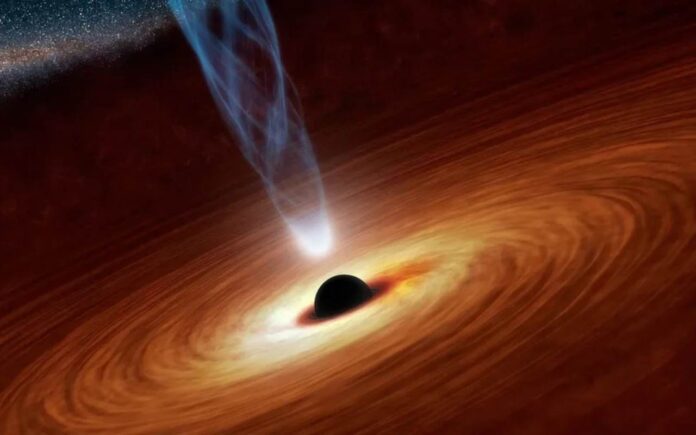A black hole is an area of spacetime with gravity so powerful that nothing—not even light or radio waves—can get out. Numerous investigations have focused on these intriguing astronomical objects, but many physical details remain unknown.
Recently, a theoretical study was conducted on a specific type of black hole—extremal Kerr black holes, which are uncharged stationary black holes with a coinciding inner and outer horizon—by researchers at the University of California, Santa Barbara, the University of Warsaw, and the University of Cambridge. Their research, published in Physical Review Letters, demonstrates how these particular black holes may serve as excellent “amplifiers” of hitherto undiscovered physical phenomena.
According to Phys.org, one of the study’s researchers, Maciej Kolanowski, said, “This research has its origin in a previous project started during my visit to UC Santa Barbara.” I first brought up the topic of extremely cold black holes (or extremal black holes) with Gary Horowitz at UCSB and Jorge Santos at Cambridge. It didn’t take long for us to figure out that generic extremal black holes don’t have the same appearance as we’d assumed.
Kolanowski, Horowitz, and Santos demonstrated in a previous study that extremal black holes are subject to infinite tidal forces in the presence of a cosmological constant. If anything alive were to fall into the black hole, they would be annihilated by the immense gravity well before they reached the centre. However, the group demonstrated that if the cosmological constant is negative, as is anticipated in many astrophysical scenarios, then this effect disappears.
“The current paper was inspired by the weekly gravity lunch at UC Santa Barbara,” Grant Remmen said. I questioned Horowitz after he gave a seminar about his research on black hole boundary singularities about whether other forces may give birth to comparable events. Inspiration came to me from my experience working with effective field theories (EFTs), specifically in the creation of quantum corrections for physical models. I asked Horowitz if quantum adjustments to the Einstein equations (the higher-derivative terms) may cause singularities on the horizons of really massive black holes.
Horowitz and Remmen began working together with Kolanowski and Santos after Remmen communicated his notion with them in the hopes of putting it to the test through a series of computations. The team used Einstein gravity with its most advanced quantum corrections in their computations.
The Riemann tensor, a mathematical construct describing the curvature of spacetime, is linear in the Einstein equations, as Remmen demonstrated. Cubic (third power) and quartic (fourth power) factors in the curvature are the most prominent corrections to Einstein’s theory in three-dimensional space. Higher-derivative terms are so-called because curvature is a measure of the derivatives of the spacetime geometry.
We determined how these higher-derivative factors affected the dynamics of black holes with fast rotation rates.
When the event horizon is moving at the speed of light, black holes at the extremes rotate at the fastest conceivable pace. Researchers found that extremal black holes have solitary horizons and infinite tidal forces due to the higher-derivative EFT corrections. This is in striking contrast to the fact that the tidal forces exerted by a standard black hole are finite and only become infinite at its singularity.
As Remmen put it, “the singularity jumps from the centre of the black hole out to the horizon, where you wouldn’t expect it.”” The coefficient value in front of a given EFT phrase, the ‘dial settings’ in the rules of physics, are determined by the couplings and particle types existing at high energy and small distances. Coefficients in the EFT are thus responsive to emerging physics.
In addition, the degree of the divergence in tides at the horizon of extremal black holes and the possibility of tidal singularity were found to strongly depend on the EFT coefficients, as discovered by Kolanowski, Horowitz, Remmen, and Santos. Calculations show that the spacetime geometry close to the horizon of these black holes is sensitive to novel physics at greater energies, suggesting that these black holes may be a window into the universe.
For the values of these EFT coefficients created by the Standard Model of particle physics, “this unexpected singularity is present,” said Remmen.
The unexpected nature of our findings suggests that the low-energy model of physics can fail in unexpected circumstances. Between different length scales, there is typically a ‘decoupling’ in physics. Hydrodynamics, for instance, can be used to describe waves without going into specifics about water molecules. The low-energy EFT does indeed fail at the horizon of rapidly spinning black holes.
The team’s simulations, taken as a whole, suggest that extremal Kerr black holes may have some promise for investigating hitherto unknown physics. Even though these black holes’ horizons can be enormous in size, an endlessly big curvature (and so, infinite tidal forces) was not anticipated in the EFT. Based on their findings, it appears to do so.
“In future work, we are interested in exploring whether the singularities can be resolved by ultraviolet physics,” Remmen said. For example, “It is an important open question whether the sensitivity of the horizon to novel physics maintains all the way to the Planck scale or whether the horizon’smooths out’ at the short-distance scale associated with the EFT. We’re also on the lookout for other instances in which localised effects could have outsized global consequences.
Reference:
Gary T. Horowitz et al, Extremal Kerr Black Holes as Amplifiers of New Physics, Physical Review Letters (2023). DOI: 10.1103/PhysRevLett.131.091402
